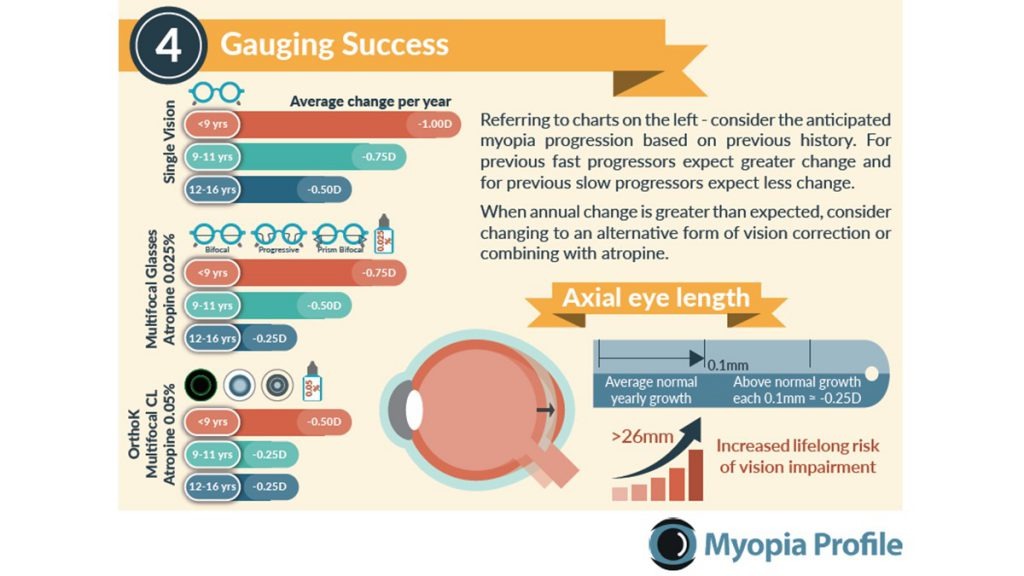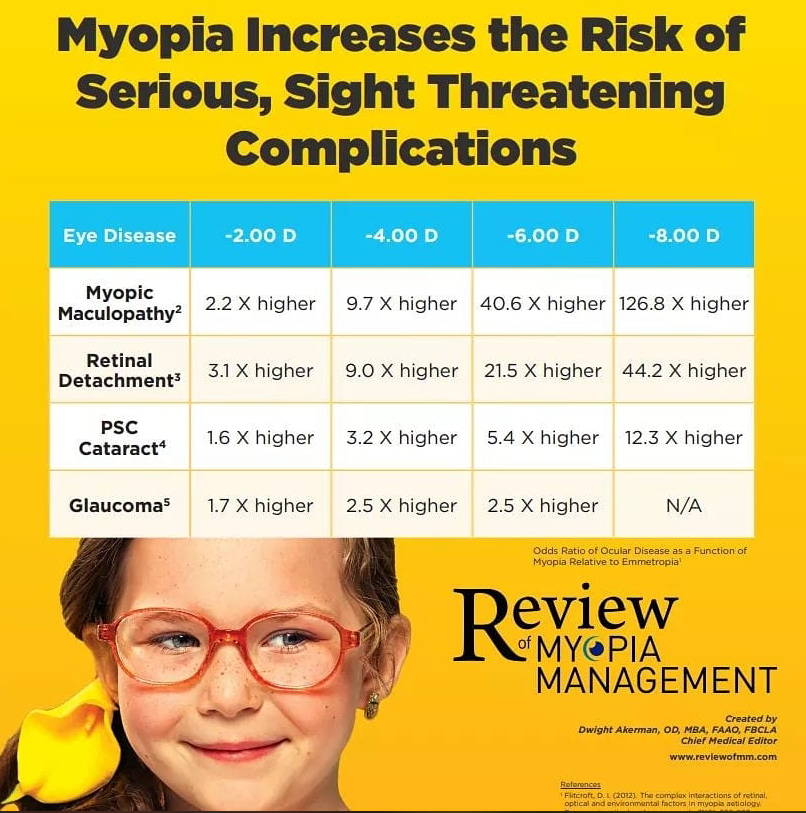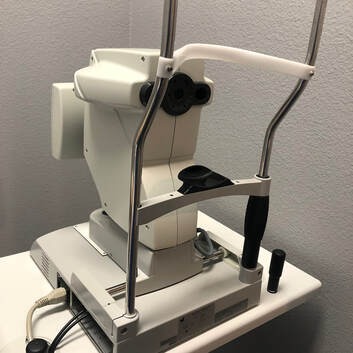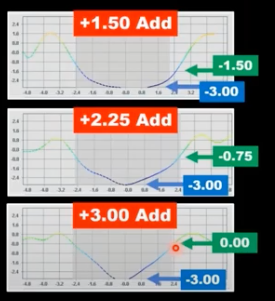What is Myopia?

Myopia (near-sightedness) is either inherited or caused by certain lifestyle behaviors. It is often discovered in children when they are between 8 to 12 years old, although it has been more prevalent in younger children in recent years. During childhood and teenage years, when the body and eyes grow rapidly including the eyeball, the amount of myopia may increase.

The table above demonstrates the risk factors that are associated with myopia progression. For example, a young female myopic child of Asian ethnicity and myopic parents that does not spend time outdoors and does excessive near work has an increased risk of myopic progression.
References
- Flitcroft DI. The complex interactions of retinal, optical and environmental factors in myopia aetiology. Prog Retin Eye Res 2012; 31: 622-660.
- Saw SM, Nieto FJ, Katz J et al. Familial clustering and myopia progression in Singapore school children. Ophthalmic Epidemiol 2001; 8: 227-236.
- Donovan LA, Sankaridurg P, Ho A et al. Rates of Myopia Progression in Children. Invest Ophth Vis Sci 2010; 51.
- Sankaridurg P, Holden BA, Donovan LA et al. An Annual Rate of Myopic Progression Model for Asian children. Invest Ophth Vis Sci2014; 55.
- Saw SM, Tong L, Chua WH et al. Incidence and progression of myopia in Singaporean school children. Invest Ophth Vis Sci 2005; 46: 51-57.
- Loman J, Quinn GE, Kamoun L et al. Darkness and near work: myopia and its progression in third-year law students. Ophthalmology2002; 109: 1032-1038.
- Donovan L, Sankaridurg P, Ho A et al. Myopia Progression Rates in Urban Children Wearing Single-Vision Spectacles. Optometry Vision Sci 2012; 89: 27-32.
- Hyman L, Gwiazda J, Hussein M et al. Relationship of age, sex, and ethnicity with myopia progression and axial elongation in the correction of myopia evaluation trial. Arch Ophthalmol-Chic 2005; 123: 977-987.
- Wong CW, Tsai A, Jonas JB et al. Digital Screen Time During COVID-19 Pandemic: Risk for a Further Myopia Boom? Am J Ophthalmol2020.
- Kinge B, Midelfart A, Jacobsen G et al. The influence of near-work on development of myopia among university students. A three-year longitudinal study among engineering students in Norway. Acta Ophthalmol Scan 2000; 78: 26-29.
- Liu XN, Naduvilath TJ, Wang JJ et al. Sleeping late is a risk factor for myopia development amongst school-aged children in China. Sci Rep-Uk 2020; 10.
- Saw SM, Nieto FJ, Katz J et al. Factors related to the progression of myopia in Singaporean children. Optometry Vision Sci 2000; 77: 549-554.
What are the long-term implications of having Myopia?

Having higher myopia can lead to a higher risk of eye problems. High levels of myopia occur when the eye elongates causing the retina to stretch. Stretching of the retina can be serious and may cause reduction or loss of vision.

What can I do for my child to reduce their myopia?
Solution: Myopia Management
There is no way to completely stop the progression of myopia, but there are a number of effective ways to manage its progression by 50-60%. These Treatment options include:
1. Low-Dose Atropine eye drops
The eye drops would be applied once a day and it is commonly used in conjunction with "myopia control" eyeglasses to enhance the effect.
2. MiSight Daily soft contact lenses
These contact lenses are worn for 10 hours daily for 6 days a week.


3. Euclid Emerald Orthokeratology Lenses
This is a method where a contact lens retainer applies gentle pressure on the surface of the eyes overnight to mold the cornea so that your child is free of wearing glasses or contacts during all waking hours. This treatment frees them of wearing glasses or contacts during sports, swimming, and other activities they love.
FREQUENTLY ASKED QUESTIONS


Gauging Success in Myopia Management

Orthokeratology, Multifocal contacts, and 0.05% Atropine are the most effective ways to slow accelerated myopia progression.
Normal eye growth is 0.1mm per year. 0.1mm eye growth is about -0.25D of myopia progression.
>26mm of eye length can increase lifelong risk of vision impairment
Reducing myopia reduces your child's risk of serious ocular pathology

If you have a -6.00 Rx, and decide to do nothing to treat your myopia, you are at a 21.5x risk for a retinal detachment and a 40x risk for myopic maculopathy.

Evidence shows that if you treat myopia and reduce it by 50%, you can significantly reduce your risk of serious eye diseases.


What sets Golden Eyes Optometry from another office?
Our Technology
We use the latest in technology that allows us to:
Establish a baseline for your child's myopia (cycloplegic refraction)
Monitor your child for normal ocular growth versus accelerated myopic progression (axial length change)
Zeiss IOL Master
We use the IOL Master (optical biometer) to measure your child's eye length (axial length). As your child grows, so do their eyes. Our goal is detect the difference between normal ocular growth versus accelerated myopic progression. Since a longer eye can lead to a stretched retina, it is important that we know the rate at which your child's eyes grow.
Measuring eye growth by ONLY your child's prescription DOES NOT correlate to a specific eye length. Usually prescription changes lag behind eye length changes. So that means that if your child has been monitored only through prescription, then your child has missed out on length changes to know whether treatment was effective to begin with.
Very few offices in Clark County use this technology to measure axial length for children.
Medmont E300 & Topcon CA-800


A quality topographer is essential in monitoring how the cornea changes overtime with myopia treatment. Having TWO accurate topographers gives us the advantage of creating accurate lenses that resemble your child's eye, which in turn, gives better results. Custom lenses are the healthiest option for your child.

With our software analysis, we are able to determine the level of induced spherical aberration created that will slow down eye growth.

Determining increasing plus power in the design of your child's lens is important in judging myopia control. The more the spherical aberration, the better the myopia control.
Without this technology, treatment zone size is unknown.
In Short: What WE DO and what other offices DO NOT do...
- 1We measure axial length
- We provide your child with an interim Rx (we have an onsite lab)
- We have the right technology to manage myopia
- We make Orthok fun for your child

Which Treatment option is best for my child?
Myopia Management Consultation & Testing
Patient Eligibility: Your child must have had an eye exam within 2 months of obtaining myopia management consultation. If your child had an eye exam outside our office, your records must be forwarded to us. You are responsible for providing those records to our office whether given to us digitally or printed.
Overview of our Myopia Management Consultation & Testing : A preliminary consultation will help evaluate your child's risk of developing myopia and potential complications based on your family ocular history, their vision demand, and previous history of myopic development. We will also analyze your spectacle prescription, perform a cycloplegic refraction, and measure your child's axial length to determine a baseline for your child's eyes and see which management option might work best for your child. The strengths and limitations of each option will be discussed.
The fee for the consultation and testing will be credited toward the global fee of the Myopia Management Program suited for your child.
Schedule an appointment with one of our doctors to learn more on how we can treat and manage your child's myopia.




